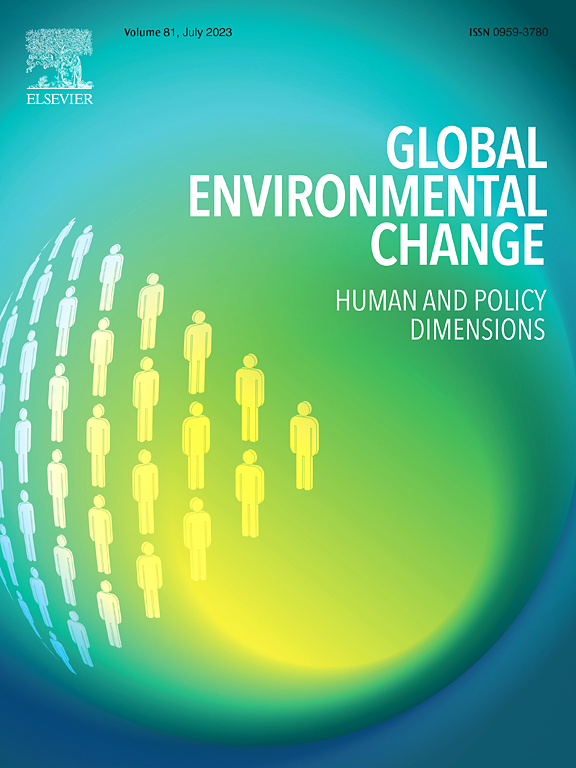网络海岸线:人类对海平面上升的适应与湿地迁移的脆弱性相互作用综述
IF 9.1
1区 环境科学与生态学
Q1 ENVIRONMENTAL SCIENCES
引用次数: 0
摘要
面对紧迫的气候风险,许多人类和非人类行为体正在适应气候变化,这种适应有时会将脆弱性转移给其他行为体。变化的脆弱性是一种适应不良,鉴于许多部门和地区的适应不良发生率日益增加,了解脆弱性是适应规划的关键组成部分。本综述创建了一个分析框架,称为脆弱性相互作用框架,以识别自然科学和社会科学文献中转移脆弱性的实例,并使用系统方法对其进行解释。为了证明其实用性,将分析框架应用于沿海适应海平面上升的背景下,研究沿海挤压和湿地迁移的主题。沿着某些海岸线,人类正在建造保护性基础设施,如海堤和堤坝,以保护自己免受海平面上升的影响。与此同时,沿海湿地——世界上最有价值的生态系统之一——能够适应海平面上升,因为它们可以向陆地迁移。这种湿地适应常常被人类海岸线开发和基础设施所阻碍,这种现象被称为“海岸挤压”。然而,迁徙的湿地也可能以消极的方式影响人类行为者。本综述确定了53种不同的脆弱性在物质、经济、环境、社会、文化和制度方面在人类和非人类行为体之间发生变化的方式。这些相互作用反映了特定的生物物理和社会背景,并可以在多个空间和时间尺度上运作。由于这些复杂的相互作用,适应规划必须着眼于制定跨部门和跨尺度的解决方案,将适应置于更大的社会生态背景下,考虑分阶段的方法,与社区合作,建立当地适应能力,并解决沿海转型中固有的个人、社会和文化损失。总体而言,脆弱性相互作用框架可以用作研究或规划工具,以绘制观察到的或假设的脆弱性变化。本文章由计算机程序翻译,如有差异,请以英文原文为准。
Networked shorelines: A review of vulnerability interactions between human adaptation to sea level rise and wetland migration
Facing urgent climate risks, many human and non-human actors are adapting to climate change with adaptations that sometimes shift vulnerabilities to other actors. Shifting vulnerabilities is a type of maladaptation and understanding them is a critical component of adaptation planning given the growing incidence of maladaptation across many sectors and regions. This review creates an analytical framework, called the Vulnerability Interactions Framework, to identify instances of shifting vulnerabilities from across the natural and social science literature and interpret them using a systematic approach. To demonstrate its utility, the analytical framework is applied in the context of coastal adaptation to sea level rise on the topics of coastal squeeze and wetland migration. Along certain shorelines, humans are building protective infrastructure, such as sea walls and levees, to protect themselves from sea level rise. Meanwhile, coastal wetlands—one of the world’s most valuable ecosystems—are able to adapt to sea level rise when they can migrate landward. This wetland adaptation is often blocked by human shoreline development and infrastructure—a phenomenon known as coastal squeeze. Yet migrating wetlands may also impact human actors in negative ways. This review identifies 53 distinct ways that vulnerabilities can shift across human and non-human actors on physical, economic, environmental, social, cultural, and institutional dimensions. These interactions reflect particular biophysical and social contexts and can operate on multiple spatial and temporal scales. Because of these complex interactions, adaptation planning must look towards developing solutions that are cross-sectoral and cross-scalar in scope, place adaptation within a larger socio-ecological context, consider a phased approach, engage with communities, build local adaptive capacity, and address personal, social, and cultural losses inherent in coastal transformations. Overall, the Vulnerability Interactions Framework can be used as a research or planning tool to map observed or hypothetical shifts in vulnerability.
求助全文
通过发布文献求助,成功后即可免费获取论文全文。
去求助
来源期刊

Global Environmental Change
环境科学-环境科学
CiteScore
18.20
自引率
2.20%
发文量
146
审稿时长
12 months
期刊介绍:
Global Environmental Change is a prestigious international journal that publishes articles of high quality, both theoretically and empirically rigorous. The journal aims to contribute to the understanding of global environmental change from the perspectives of human and policy dimensions. Specifically, it considers global environmental change as the result of processes occurring at the local level, but with wide-ranging impacts on various spatial, temporal, and socio-political scales.
In terms of content, the journal seeks articles with a strong social science component. This includes research that examines the societal drivers and consequences of environmental change, as well as social and policy processes that aim to address these challenges. While the journal covers a broad range of topics, including biodiversity and ecosystem services, climate, coasts, food systems, land use and land cover, oceans, urban areas, and water resources, it also welcomes contributions that investigate the drivers, consequences, and management of other areas affected by environmental change.
Overall, Global Environmental Change encourages research that deepens our understanding of the complex interactions between human activities and the environment, with the goal of informing policy and decision-making.
 求助内容:
求助内容: 应助结果提醒方式:
应助结果提醒方式:


